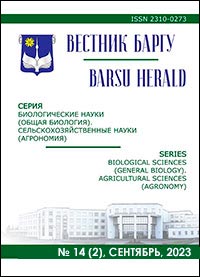MORPHOLOGY OF THE EPIPHARYNX OF THE TUMBLING FLOWER BEETLELARVAE (COLEOPTERA: MORDELLIDAE)
Keywords:
Mordellidae; morphological features; mature larvae; epipharynx; diagnostic charactersAbstract
The larvae of tumbling flower beetles are described for a small number of species. In most cases works devoted to
them do not have any data on morphological characteristics of the epipharynx. This morphological structure is poorly
studied. The aim of the present work is first of all to lay the foundation for further study of the epipharynx of the
Mordellidae larvae. The morphological features of the epipharynx of the mature larvae of tumbling flower beetles were
analyzed on the example of 8 species: Mordella holomelaena Apfelbeck, 1914; Mordellaria aurofasiata (Comolli, 1837);
Natirrica humeralis (Linnaeus, 1758); Mordellistena pumila (Gyllenhal, 1810); M. secreta Horák, 1983; M. kraatzi
Emery, 1876; M. weisei Schilsky, 1895 and M. falsoparvula Ermisch, 1956. Photographs of the epipharynx of these
species and the patterns of its setae are given. The morphological variability of the epipharynx of larvae of some species
is pointed out. Terminology for describing the epipharynx of the Mordellidae larvae is proposed. It is shown that the
epipharynx of larvae of various species of tumbling flower beetles is characterized by a wide range of morphological
features including the length of distal portion of median projection; the length and density of elongated setiform
microtrichia on its apex; the shape and location of the processes of tormae; the shape, location, number and size of setae;
the presence or absent of microtrichia on its lateral portions. Along with the characters of apical processes, antennae,
maxillolabial complex and some other structures, morphological features of the epipharynx can be considered as one of
the most significant for the identification of the tumbling flower beetle larvae. Therefore, the morphology of the
epipharynx should be used to describe the larvae of Mordellidae and develop keys for their identification.
Fig. 16. Ref.: 15 titles.
Downloads
Published
Issue
Section
License
Copyright (c) 2023 Вестник БарГУ Серия "Биологические науки. Сельскохозяйственные науки"
Это произведение доступно по лицензии Creative Commons «Attribution-NonCommercial» («Атрибуция — Некоммерческое использование») 4.0 Всемирная.
Авторы сохраняют за собой право заключать определенные договорные соглашения, касающиеся неисключительного распространения опубликованной версии работы (например, размещать ее в институциональном репозитории, публикация в книге) со ссылкой на ее первоначальную публикацию в этом журнале.





